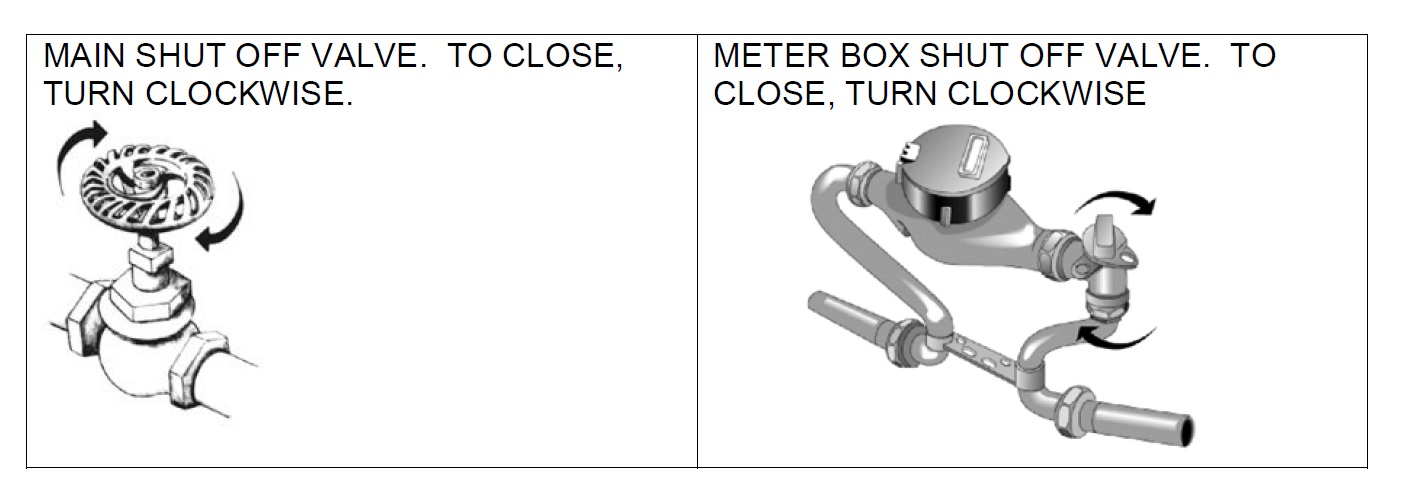Before an emergency: find your home's water shut-off valve
Your main shut-off valve controls the flow of water into your home or building. If a pipe breaks, you can stop excessive water loss and flooding by turning off the water. The shut-off valve is commonly located in the basement, garage or outdoor by the foundation, often near the front faucet.
If your property does not have a main shut-off valve or it is broken, you should have one installed or repaired. But in an emergency, you can also turn off your water at the shut-off valve in the meter box.
To operate the shut-off valve on your water meter:
Once you locate your meter, use a crescent wrench or meter valve key (available at hardware stores) and turn the valve clockwise.
How to Protect Your Pipes
- Insulate pipes and faucets in exposed or unheated areas. Outdoor faucets and pipes in unheated attics, garages, and crawl spaces are most vulnerable to freezing. For pipes that tend to freeze even when insulated, electrical heat tape may help.
- Disconnect outside hoses and drain any water remaining in the hose and hose bib.
- Keep garage doors closed if there are water supply lines in the garage.
- Open kitchen and bathroom cabinet doors to allow warmer air to circulate around the plumbing. Be sure to move any harmful cleaners and household chemicals up out of the reach of children.
- Let the cold water drip from the faucet served by exposed pipes when the weather is very cold outside. Running water through the pipe - even at a trickle - helps prevent pipes from freezing.
- Keep the thermostat set to the same temperature both during the day and at night. A higher heating bill may help prevent a more expensive pipe break.
- Set to a temperature no lower than 55° F if going away during cold weather.
- Winterize vacant buildings for homes or properties left unheated for extended time:
- Turn off the main shut-off valve.
- Turn off the water heater.
- Open indoor and outdoor faucets to drain the pipes.
- Drain irrigation systems.
- Flush toilet to drain toilet tanks, but not toilet bowls.
- Visit the American Red Cross for more winter storm preparedness info
What to Do if Pipes Freeze or Break
- You may have a frozen water pipe if you turn on a faucet and only a trickle comes out. The most likely places for frozen pipes include against exterior walls or where your water service enters your home.
- Thaw frozen pipes and faucets by wrapping them with rags and pouring hot water over the rags until the water is flowing. After thawing, remove the wet rags and wrap pipes with dry insulation to prevent refreezing.
- Never use an open flame or electric device to thaw frozen pipes because you could cause a fire or electric shock. After thawing the pipes, you may discover leaking from a broken pipe.
- If a pipe breaks, immediately close the main shut-off valve to stop excessive flooding. If you don't have a shut-off valve or it is broken, turn off the water at the water meter.
- Call a licensed plumber if you are unable to locate the frozen area, if the frozen area is not accessible.
You are responsible for protecting water pipes from freezing and for repairing broken pipes on your property. If you lose all water during a freezing period, thaw the pipes as suggested above or call a plumber. If you suspect the meter is frozen, call Bellevue Utilities at 425-452-7840.

